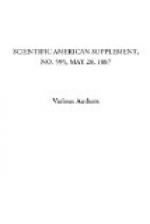[Illustration: FIG. 3.—PROPORTIONS OF TRANSMITTED COLORS.]
For, however small the particles may be, they will have a greater tendency to sink in a rare air than in a denser one, and less water vapor can be held per cubic foot. Looking, then, from my laboratory at South Kensington, we have to look through a proportionately larger quantity of suspended particles than we have at a high altitude when the air thicknesses are the same. And consequently the absorption is proportionately greater at sea level that at 8,000 feet high. This leads us to the fact that the real intensity of illumination of the different rays outside the atmosphere is greater than it is calculated from observations near sea level. Prof. Langley, in this theater, in a remarkable and interesting lecture, in which he described his journey up Mount Whitney to about 12,000 feet, told us that the sun was really blue outside our atmosphere, and at first blush the amount of extra blue which he deduced to be present in it would, he thought, make it so. But though he surmised the result from experiments made with rotating disks of colored paper, he did not, I think, try the method of using pure colors, and consequently, I believe, slightly exaggerated the blueness which would result.
I have taken Prof. Langley’s calculations of the increase of intensity for the different rays, which I may say do not quite agree with mine, and I have prepared a mask which I can place in the spectrum, giving the different proportions of each ray as calculated by him, and this when placed in front of the spectrum will show you that the real color of sunlight outside the atmosphere, as calculated by Langley, can scarcely be called bluish. Alongside I place a patch of light which is very closely the color of sunlight on a July day at noon in England. This comparison will enable you to gauge the blueness, and you will see that it is not very blue, and, in fact, not bluer perceptibly than that we have at the Riffel, the color of the sunlight at which place I show in a similar way. I have also prepared some screens to show you the value of sunlight after passing through five and ten atmospheres. On an ordinary clear day you will see what a yellowness there is in the color. It seems that after a certain amount of blue is present in white light, the addition of more makes but little difference in the tint. But these last patches show that the light which passes through the atmosphere when it is feebly charged with particles does not induce the red of the sun as seen through a fog. It only requires more suspended particles in any thickness to induce it.
In observations made at the Riffel, and at 14,000 feet, I have found that it is possible to see far into the ultra-violet, and to distinguish and measure lines in the sun’s spectrum which can ordinarily only be seen by the aid of a fluorescent eye piece or by means of photography. Circumstantial evidence tends to show that the burning of the skin, which always takes place in these high altitudes in sunlight, is due to the great increase in the ultra-violet rays. It may be remarked that the same kind of burning is effected by the electric arc light, which is known to be very rich in these rays.




